The hot summer months are perfect for RVing. But the summer heat can bake you right inside your RV and make your stay in there uncomfortable, unbearable, and one you’d just want to forget.
Gladly, you can count on a high-efficiency RV air conditioner to get rid of the hot air in your vehicle and replace it with cool, fresh, and clean air for a comfortable camping experience.
So, what’s the best RV air conditioner to get for your camper?
Down below, we have outlined our picks for some of the top models you can find on the market today alongside a buying guide on how to choose the right AC unit for your RV.
Image
Name
Editor's Rating
Price
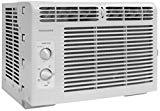
Frigidaire FFRA0511R1E Mini-Compact Air Conditioner
Check Price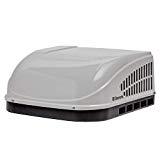
Dometic B59516.XX1C0 Brisk II Polar Air Conditioner
Check Price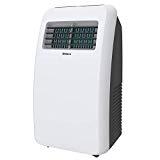
SHINCO SPF2 8,000 BTU Portable Air Conditioner
Check Price
Advent ACM150 Rooftop Air Conditioner
Check Price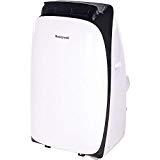
Honeywell 9000 Btu Portable Air Conditioner
Check Price10 Best RV Air Conditioner Reviews:
1. Frigidaire FFRA0511R1E Mini-Compact Air Conditioner
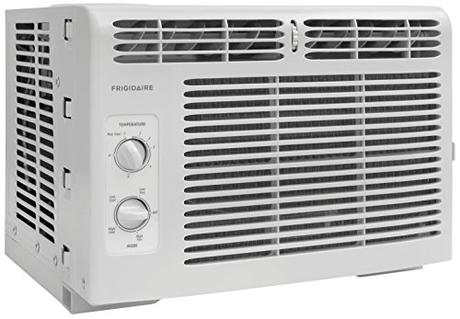
Our list of the best RV AC unit reviews starts with this unit from Frigidaire. This AC unit comes with a mini-compact design and is meant for window mounting. A complete window mounting kit is included in the package for a hassle-free, quick setup.
Once the setup is complete, this Frigidaire works tirelessly and quietly to cool and keep the inside of your RV comfortable when RVing in hot weather. It has the ability to dehumidify up to 1.1 pints per hour and cool up to 150 square feet space, making it ideal for servicing an entire RV living room or bedroom.
Since it also comes with integrated antibacterial mesh wire, it also cleans the air entering your RV and eliminating any harmful bacteria present, ensuring you live in a clean and healthy environment.
You also have total control over this AC, thanks to its mechanical rotary control. This allows you to adjust the cooling and fan speeds. And the top, full-width 2-way air direction control lets you control the direction of air.
Highlighted Features:
- Up to 5000 BTU cooling power
- Window-mounted installation
- Cools up to 150sq. ft. rooms
- Low power startup
- Quiet operation, effortless start
- Exterior dimensions: 12 H x16 W x 15-1/4 D inches
- 2-way air direction control
2. Dometic B59516.XX1C0 Brisk II Polar Air Conditioner
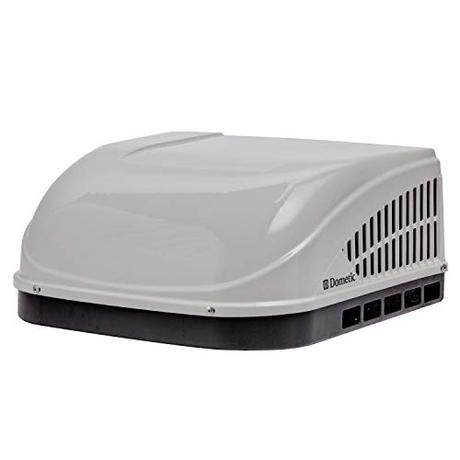
If you’re looking for a small RV air conditioner that you can easily install on your RV rooftop, this Dometic Brisk II unit is a great option. The AC is a result of Dometic redesigning and re-engineering one of their most popular RV AC to achieve more power and greater performance.
It’s no surprise that one of the major improvements notable in this unit is greater performance. It boasts of a nominal cooling capacity of up to 13,500 BTU that’s adequate for cooling recreational vehicles of all sizes.
Unlike its predecessors, this unit is compatible with standard 14x 14 air vents. It also feels 14% lighter and delivers up to a 15% increase in airflow than the previous units from the manufacturer.
It’s also worth noting that this new model features a sleek design and you can easily install it on your RV rooftop with just a few tools. The fact that it’s eco-friendly means that it doesn’t consume a lot of power.
And remember, it also comes deigned with more durable materials to enable it to withstand shocks, vibration, and stay strong over the years.
Highlighted Features:
- 13,500 BTU/hour cooling capacity
- Environmentally friendly RV air conditioner
- High-performance fan & motor
- Easy installation and maintenance
- Dampening brackets reduce noise, vibration
- 2-year protection warranty
3. SHINCO SPF2 8,000 BTU Portable Air Conditioner
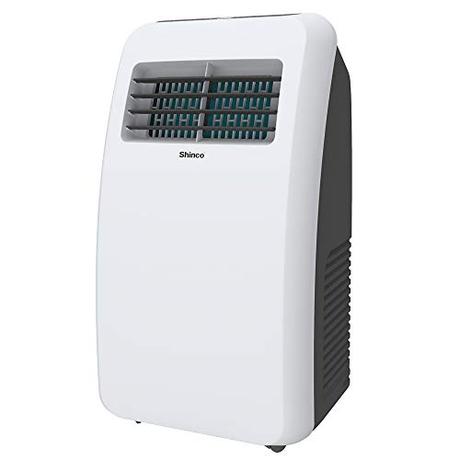
Shinco takes pride in the production of top of the line air conditioners and dehumidifiers for the past 20plus years. This particular unit from the manufacturer is one of the top-rated small RV AC units that help you have a comfortable RVing experience in summer weather.
Despite its attractive price tag, this portable air conditioner delivers as high as 8000 BTU cooling power. In other words, it quickly and effectively cools spaces 200 - 350 Sq.ft. in your RV.
Moreover, it has an impressive dehumidifying capacity amounting to 60 pint per day. This helps stop the growth of bacteria and molds in your RV, making the air inside cool, dry, and 100% healthy!
You’ll appreciate the unit’s 2-speed fan that helps you set the right speed for your cooling needs. And when you want cool and fresh air at night, you can switch to the low-speed mode which also effectively, yet quiet enough not to disturb your sleep.
With a straightforward installation process, you won’t struggle to set up this unit in your RV. The intuitive digital display controls and the full-featured make it incredibly simple to operate. As a portable unit, the built-in handle plus casters allow you to easily move this AC from place to place.
Highlighted Features:
- Compact, portable air condition
- Can cool spaces up to 200 - 350 Sq.ft
- 8,000 BTU cooling capacity
- 2-speed fan to meet your cooling needs
- 60 pint dehumidifying capacity per day
- Self-evaporative cooling capabilities
- Quieter low-speed mode operation
- Easy to use; intuitive control panel & LED display
- Easy and quick installation
4. Advent ACM150 Rooftop Air Conditioner

Want a high-end rooftop air conditioning solution for your RV? If yes, say hello to this Advent model that comes specially engineered to withstand all the possible challenges associated with the RV environment.
One thing that makes this air conditioner involves its incredibly high cooling capacity of up to 15,000 BTUs. This is the highest we have seen so far on this list…and in our honest opinion, it’s sufficient for combating the hot stale air in your RV and providing you cool, fresh air supply.
You can adjust its fan speed in up to 3 settings to meet your unique cooling needs. The lowest speed makes the unit operate in silence, which is good if you’re sleeping.
Thanks to its lightweight and compact design, installing this air conditioner in your RV will be the easiest part.
Note that this AC unit is made using high-grade materials for the ultimate quality. It has a sturdy metal constructed base pan and thick, watertight vent opening with up to 6 dense foam support pads. These give the unit overall great durability that enables it to hold to the toughest conditions in your RVing life.
Since this unit comes in both white and black shroud options, you can easily pick one that matches the color of your RV rooftop.
Highlighted Features:
- 15,000 BTUs cooling power
- Rigid, metal constructed base pan
- Premium, thick watertight vent opening gasket
- Fan installs in standard vent openings
- Up to 3 fan speed settings
- Can withstand the toughest RVing conditions
5. Honeywell 9000 Btu Portable Air Conditioner
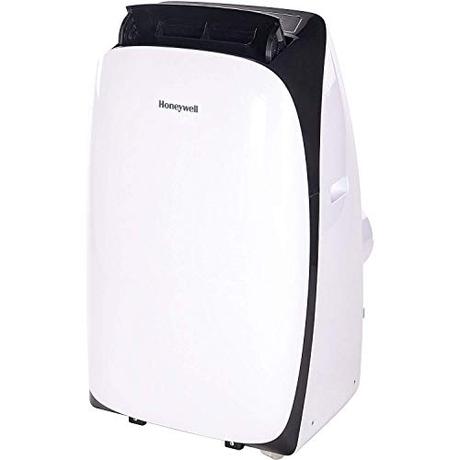
Here’s another small RV air conditioner for you if space is a premium in your RV. This is a highly portable unit that comes with a truly stylish design, making it the perfect model for RVers who put style first.
Despite the compact design, this AC unit packs a powerful punch with up to 9000 BTUs worth of cooling power to ensure you have an enjoyable stay in your RV. It comes equipped with an automatic vertical window motion that helps cool, fresh air around your RV for a more efficient and consistent cooling experience.
The little guy also comes equipped with dual filters that help trap dust and hairs to ensure you take in healthy air while extending the life and performance of the air conditioner.
Like our previous model, this unit also has a 3-speed cooling to enable you to control how it cools your RV interior.
Other notable features include a built-in dehumidifier, digital display with remote, and thermal overload protection to ensure your safety and peace of mind.
Highlighted Features:
- 9000 BTU RV AC
- Built-in dehumidifier
- Stylish, powerful, and dependable
- Thermal overload protection
- Dual filters to protect from dust & hair
- Automatic vertical window motion
- Up to 3 fan speeds to choose from
- Digital display with remote control
6. Dometic 640315C Penguin II Air Conditioner
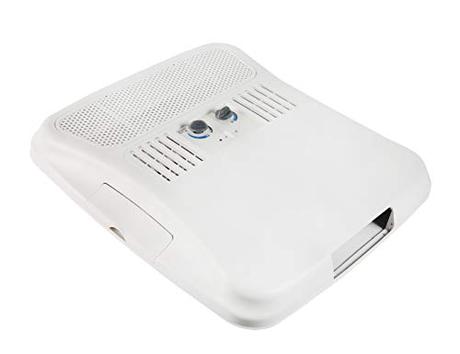
Dometic comes up again on our list of top camper air conditioner reviews. But this time they have a slightly different offer…a low profile RV air conditioner whose aerodynamic design helps minimize wind drag and save on your vehicle fuel.
The powerful AC installs on your camper rooftop to offer you a great cooling solution in the hot weather. It has a nominal cooling power of 13, 500 that’s sure to cool your entire RV efficiently and consistently.
Since this Dometic has a straightforward control interface, it’ll prove quite easy to use and manipulate for you. The high-performance blower has 3 blowing speeds to let you regulate the airflow as per your needs.
You can fit this air conditioner on virtually any unit since it works with both ducted and non-ducted air conditioners.
With its tough rib-reinforced base pan, you can trust this unit to hold up to just any outdoor challenges it might encounter. Its sleek, contemporary shroud design with low profile design helps reduce wind drag for improved mileage.
Highlighted Features:
- 13,500 BTU cooling capacity
- Aerodynamic, low-profile design
- Easy to reach and use controls
- Three-speed blower
- Fits standard 14x14 roof openings
- Suitable for ducted & non-ducted installation
7. Airxcel 08-0080 Mach 15 15.0 Arctic

If your current RV air conditioner has become a disappointment of late, consider replacing it with this higher-performance Airxcel 08-0080 Mach 15. This is one of the most powerful RV air conditioner units you can find on the market today.
We love the fact that it comes with a really high cooling output capacity of up to 15,000 BTUs. Needless to mention, this is such strong airflow that will work well with any ducted system to supply your entire with cool and fresh air.
Probably this Airxcel’s secret to high performance lies in the 1/3 horsepower fan motor it comes with. This is the largest you can find in an RV A/C and is capable of delivering cool air at an outstanding rate of 300 CFM (cubic feet per minute).
RVers who have used this unit before praise it for its streamlined shape that helps its airflow and cooling efficiency. Not to forget the large evaporator and condenser coils to help enhance the unit’s ability to dissipate heat.
Being a high-end product, it should come as no surprise that this AC’s design is characterized by all-copper tubing plus gas-flux brazed joints for long-life product dependability. The shroud also features condenser coil protection for even greater durability.
Highlighted Features:
- 15,000BTUs cooling capacity
- Electric heat transfer capacity: 5,600
- 1/3 horsepower fan motor
- 320 CFM airflow
- Electrical rating: 115 VAC, 60Hz
8. Coleman Airxcel 08-0056 Mach III Ps 13.5 Arctic
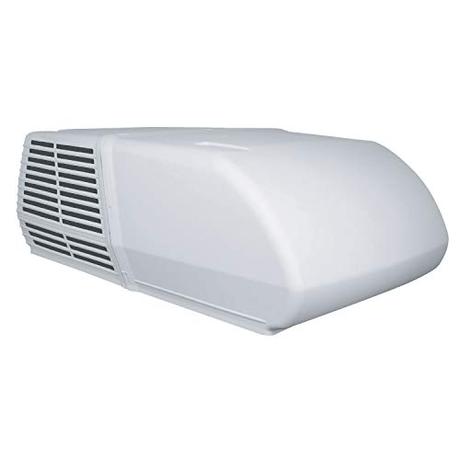
If you’re looking for a power-efficient unit, this is it! The Coleman Airxcel 08-0056 Mach III comes designed consumes less power in your RV without sacrificing its cooling performance. So, you can enjoy a cool and comfortable RV environment and get enough power for all your RV appliances.
The brains behind this product had their most popular Coleman®-Mach® 3 PLUS RV AC in mind when designing and engineering this unit. They wanted something that could keep up with the cooling performance of this air conditioner while using less electrical power.
Luckily, they were able to achieve this by matching a high-efficiency fan motor, high-efficiency compressor, plus oversized coils—all of which work together to minimize amp draw and maximize cooling.
A flow rate as high as 320 CFM further enhances the conditioner’s superior cooling capabilities. The fan has up to 2-speed settings to help you control how it conditions the air in your RV. And for those chilly winter nights, you can always fit a Coleman Mach III to this power-saving machine to supply you with 5600 Btu of hot air/ hour.
Highlighted Features:
- Cool/heat Capacity: 13,500
- 320 CFM blower
- Electrical rating: 115 VAC, 60HZ
- Powerful 1/3 HP motor
- Two-speed cooling fan
9. ASA Electronics ACM135B RV Trailer Air Conditioner
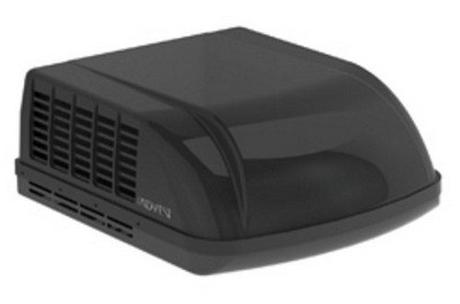
As we draw closer to the end of our top air conditioner reviews, we have another top-performance conditioner that you install on your trailer or camper rooftop. A product of ASA Electronics, this AC works with both ducted and non-ducted systems, making it compatible with just any RV.
The air conditioner has undergone independent lab testing that shows it consistently averages up to 10% greater cooling capacity than its current 13.5K rating. This means you’ll gain more BTUs with the 13,500 averaging 15,000—resulting in the ability to cool your large RV space in a shorter period of time.
This air conditioner can withstand all the rigors of your RV lifestyle. It boasts a sturdy metal frame that withstands the toughest outdoor conditions.
We also can’t fail to mention the included foam pads that help dampen vibration and allow for a quieter operation, so that you can a peaceful sleep in your RV. The premium, thick, watertight vent opening gasket dramatically reduces issues of leaks.
And with integrated overload protection, it goes without saying that this unit will hang around for longer compared to the average models out there.
For the installation part, this unit comes with everything you need to set it up on your RV rooftop. It runs on a 100% environmental-friendly coolant, making it a darling for eco-conscious RVers.
Highlighted Features:
- Compatible with ducted & non-ducted systems
- Metal construction, ridged chassis design
- BTU output: 13,500
- No-hassle 2-year warranty
- Non-ozone depleting eco-friendly refrigerant
- Removable and washable filters
10. Dometic H541816AXX1J0 Blizzard Nxt 15.0 Air Conditioner

The last best RV AV unit, but not the least one, is another product from the leading Dometic brand. This a superior, high-efficiency unit that leaves no stone unturned when it comes to keeping your RV interior cool, fresh, and comfortable.
One of the top features that keep this AC ahead of its competitors revolves around its powerful motor and fan, both of which deliver industry-leading 350 CFM airflow for the ultimate cooling capabilities.
It also boasts of advanced engineering that helps maximize airflow around the evaporator coils for even better and more efficient cooling performance.
The conditioner’s unique construction that further sets it from the park. It has EPP foam (expanded polypropylene) construction that translates to reduced weight, better insulation, and combating unwanted condensation.
The use of heavy metal has been kept in low as a measure to improve the unit’s performance and keep the noise as low as possible.
The sleek, aerodynamic unit features a composite base pan plus injection-molded shroud that’s UV stable and can withstand high impact—making it remain durable in the most extreme conditions.
Highlighted Features:
- High-compact polypropylene shroud
- Vibration isolation for quieter operation
- 350 CFM blower
- High capacity output fan and motor design
- Sleek and aerodynamic design
RV Air Conditioner Buying Guide
Right now, the market is filled with varieties and varieties of air conditioners. You don’t expect all these units to come with the same build quality, cooling power, and sets of features.
To get the best RV air conditioner that meets your cooling needs and personal preferences, you need to know exactly what to look for in a typical unit.
Here are some crucial factors to help you make a wiser decision:
Type of AC Unit
Before you can even start your selection, you’ll need to familiarize yourself with the various types of RV air conditioners you’ll get on the market.
The two most common types include rooftop and portable models as described below:
1. Rooftop
As you can easily tell from its name, this type of air conditioner comes designed for installing on your camper roof.
The rooftop units can further be subdivided into duct and ductless systems.
-Ducted units easily integrate with the existing airflow system in your RV to push air around the entire space. They’re best suited for larger campers.
-Duct-less units, on the other hand, are suitable for smaller RVs. They cost less and operate more quietly than the ducted models.
One of the top benefits of this type of AC is that it’s installed outside your RV, helping you save space inside your RV.
Unfortunately, a rooftop unit can block the amount of natural light entering your RV, unless you find a model with an integrated window.
Another downside of rooftop units is that they can get easily damaged by under low bridges or low hanging obstacles. However, getting a low profile rooftop unit can help prevent these damages while also reducing wind drag for increased fuel efficiency in these units.
2. Portable
Portable RV AC units usually come with a compact size. Unlike the rooftop models, they take space inside your RV and need extra care when handling them.
Also, note that these units don’t require any installation and you can easily move them around your RV.
If you decide to go with a portable unit, then it’s worth keeping in mind that these units have limited cooling power and can only cool a single room at a time.
3. Window
We said there are 2 main types RV AC units…but there’s also a less popular type, the window unit. This is similar to the window unit usually installed in homes.
The biggest benefits of using such units is that they offer greater cooling power, save up significant space, and are quite easy to install.
Which one of these units do you think will meet your RV cooling needs?
Our list of the top RV air cooling systems reviews above includes all these three types of units, so it’s a matter of choosing the one that meets your specific RV cooling needs and preferences.
Cooling capacity
You should also check the cooling power that comes with the AC unit you want to buy.
This is quite easy for you as it involves checking the BTU (British thermal unit) rating of the given unit. The higher this rating, the greater the cooling capacity of an RV air conditioner and the larger space it can cool.
That said, the standard BTU rating for air conditioning units is 13,500 BTU cooling power, which is enough to cool a large recreational vehicle. But you can get more or less depending on your cooling needs.
Here are some quick space estimates for different AC BTU ratings:
- 5,000 to 7,000 BTUs: 100 to 300 square feet
- 8,000 to 12,000 BTUs: 300 to 550 square feet
- 14,000 and 18,000 BTUs: 550 to 1,000 square feet
As you can see, you’ll need to take your recreational vehicle space into account to help you decide how much BTUs (or cooling capacity) you should get in an ideal conditioner for your RV.
Quick TIP: If you plan to camp in an area with extreme temperatures or high humidity, then you’d be better off with a unit with higher BTU power than the standard rating.
Power consumption
Another important consideration you should make when looking for an AC unit is the amount of power it requires to operate.
To be honest with you, some units can draw a lot of power for them to keep your RV interior cool. This can be a problem in case you’re using a portable generator as higher power means spending more money.
Look for a unit designed to keep its power consumption low without comprising its cooling efficiency. Check the wattage of the unit to get an idea of how much power it takes in.
Still at it, if you plan to cross the border with your RV, then you should also ensure you invest in a unit that works with power sources in different countries.
Size
If you want to get the most suitable air conditioner for your camper, you should also keep in mind size as one of the key considerations.
If you go with a rooftop mounted model, then make sure it’s not too tall to the point of affecting your clearing height and possibly get damaged by overhanging obstacles or when trying to pass through low bridges.
The perfect rooftop unit should come with a low profile, say around 25cm to your RV’s clearance height. A low profile AC with aerodynamic shape is even better as it helps reduce wind drag for improved vehicle mileage.
If you go with a portable model, you need to look for a model that will perfectly fit in the available space. RVs usually have limited space, so you should consider finding the smallest unit available.
Noise level
AC units usually produce some noise when running. With a fan blowing at a high speed, you don’t expect your new air conditioning unit to operate quietly.
That said, the level of noise varies from model to model.
To ensure you have enjoyable outdoor experience in your RV, we encourage you to look for the quietest RV air conditioner available. You don’t want something that keeps you awake all night because of its operating noise or disturb your peace of mind when relaxing inside your RV.
Always check the noise rating of a unit by the manufacturer before you order any unit.
Also, consider checking through the previous user reviews to see if the unit indeed works silently as its manufacturer suggests.
Ease of installation
Installation of an air conditioning unit on your recreational vehicle was a job left to the professionals some years ago.
But all that has now changed, thanks to the production of easy and straightforward to set up models that you can install on your own.
Considering that you have already spent a lot on your AC, why would you want to spend more on a professional installer if you can do it on your own?
That just doesn’t make sense financial-wise.
We advise you to look for a unit that comes with a straightforward installation you can set it up on your own and save money. And learning something new.
Air purification capabilities
The beauty of RV air conditioners is their ability to cool air in your RV as well as purify it.
They remove any odors, dust, and particles that can turn out to be a health hazard. They help improve the quality of the air you take in, regardless of the environment you’re staying in.
However, not all units have this capability.
If you want to enjoy cool as well as pure, healthy air in your RV, check that the unit you buy comes with a built-in air purification system.
If you have an individual prone to allergies on board, then a unit with air purification should become a priority.
Other considerations:
- Weight: the weight of the unit you can buy can directly affect its ease of installation, maintenance. lighter units are always easier to handle.
- Integrated heat pump: A/Cs have evolved and can help warm up your RV instead of just cooling it. A unit that comes with an integrated heat pump helps keep you warm when you RVing in the chilly winter weather.
- Integrated window: installing a rooftop air conditioner can block some of the natural light coming in. However, getting a unit with integrated helps prevent this by allowing the light to pass.
- Build quality: if you go with a rooftop air conditioner, you should ensure it has a rugged construction to withstand harsh weather elements and other tough outdoor conditioners associated with RV lifestyle to enable it to last longer.
Maintenance Tips For RV AC Unit
Wanna know the surest way to cut down the cooling efficiency of your RV AC unit, invite regular breakdowns, and reduce its lifespan?
It’s NOT taking good care of it!
Don’t assume just because you turn on your camper air conditioner and it runs well, it doesn’t need regular checkups and maintenance.
Follow these top RV AC maintenance tips to help you get the most out of your unit and keep it in top condition at all times:
BEFORE you can do any maintenance task on your unit, make sure you cut its power supply for your own safety!
- Clean the AC filters: dirty filters affect both the cooling capacity and efficiency of your air conditioning system. Luckily, most of the AC filters are made of washable materials, making them easy to clean. You simply remove them and clean, and give them time to dry completely before putting them back in.If you find that your system filters are torn, damaged or won't clean, you can replace with new ones.
- Check for bent fins: fins play a crucial role in your RV air cooling system efficiency. For this reason, bent fins make your system less efficient. Look for such fins and straight them with the help of a coil find comb (it helps you avoid damage them).
- Oil the fan motor: no RV A/C maintenance is complete without oiling the fan motor. But how you do this depends on the type that comes with your unit.
For units with regular bearings, they usually feature oiling ports at both ends of the motor so you simply fill these ports to oil the motor.
For ACs that have sleeves instead of bearings, then you’ll need to lubricate the shaft where the fan motor housing meets the sleeves.
- Clean the evaporator coils: after removing your unit’s filters, you should be able to able to access the evaporator coils. Look for the accumulation of dust and debris on these coils; if you find any of these elements, use a soft bristle vacuum attachment to get rid of them.
- Assess the condenser coils: you should also regularly check your RV AC’s condenser coil. For this part, however, you’ll need to go up to the rooftop and remove the shroud (usually held in place by several screws) to easily access the condenser coils.
Once you have removed the cover, you can use compressed air to blow out any debris present on these coils. Note that you ought to blow the air from inside out, which is why you need to remove the shroud first.
Pro TIP: Convert your RV when not in use!
Doing so helps prevent dust, dirt, and debris from entering your camper’s AC unit. They also keep it protected from unwanted elements like moisture flies and insects, and extreme weather conditions. Covering your RV simply saves you from having to deal with too many AC issues.
How often to conduct maintenance work on your RV air conditioner? As a rule of thumb, consider doing every 2 months.
Frequently Asked Questions
Q: How do RV air conditioners work?
A: The primary role of an air conditioning system in your RV is to keep you warm when camping in wet climate.
To do this, it takes in the hot air hanging inside your RV, removes the heat outside your RV, and then pushes cool, fresh air to your RV interior via the air vents.
Q: What is a heat pump in RV air conditioner?
A: A heat pump is simply a mechanical compression refrigeration system that can be easily reversed to supply your RV with either warm or cold air.
This is how the system works:
When RVing in hot weather, the pump gets rid of hot air in your RV and replace it with cool air to make you feel comfortable. When RVing in hot weather, the process gets reversed and cool air from the inside is pumped into the unit and pumped out as warm air.
Though this feature isn’t present in all RV AC units, it’s worth consideration if you want your unit to keep you warm inside your RV when you run into chilly weather.
Q: Can I run an air conditioner on a battery alone?
A: Yes, it’s completely possible to run your RV air conditioning system off batteries if you run into hot weather and can’t find an electrical outlet to plug your RV into.
However, note that you might more than one battery to enable you to obtain sufficient power needed to run your AC and to keep it running for long.
As the experienced RVers agree, how long your AC will run on batteries depends on its size as well as its BTU rating. The higher the BTU rating, the more battery power it draws and the shorter your batteries will last.
Needless to mention, this isn’t an effective way to power your RV A/C, unless you’re a full-time RVer.
A better alternative is to get a12 volt RV air conditioner than runs off the solar panel power. But keep in mind that this type of unit is highly dependent on the weather. For it to run, you’ll need to track the sun. This makes it highly unreliable.
Q: What are some of the best RV AC brands?
A: If you want to buy your new RV AC unit from a reputable manufacturer for quality assurance, then you should consider names like Dometic, Atwood, Coleman, and Airxcel.
Q: What’s the difference between ducted and ductless installation?
A: For ducted installation, the rooftop RV air conditioner gets connected to the ducts inside your RV that then distribute air to all the corners of your vehicle. An air distribution box usually sits between the AC unit and the ducts.
In this type of setup, you can easily control the settings with the help of a remote and or wall thermostat.
For a non-ducted installation, things are quite easier as the air cooling system simply takes in air from the roof and then blows it out through the bottom.
This type of system presents you with a control unit to help you set your RV temperature.
Q: How long do RV air conditioners last?
A: You can expect an RV air conditioner to last for anywhere from 3 to 5 years. That said, keep in mind that the key factors that affect the lifespan of an RV air conditioning system include the model, constructed materials used, and its usage.
Final Verdict
RVing in hot weather can only feel comfortable, more enjoyable and memorable if you’ve got the right air conditioning system installed in your RV. The perfect A/C unit will provide you with a consistent supply of cool, fresh air inside your RV regardless of how the air inside is.
using the buying advice we have shared in this guide, getting the best RV air conditioner for your camper should be easy for you. Our list of top products reflects high cooling efficiency, good quality, and reliability. These units come fully devoted to making your RVing experience in hot weather more comfortable than ever before.
